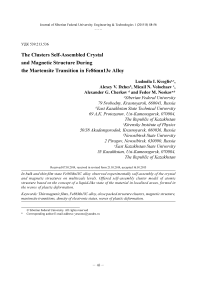The clusters self-assembled crystal and magnetic structure during the martensite transition in Fe86Mn13C alloy
Автор: Kveglis Ludmila I., Dzhes Alexey V., Volochaev Micail N., Cherkov Alexander G., Noskov Fedor M.
Журнал: Журнал Сибирского федерального университета. Серия: Техника и технологии @technologies-sfu
Статья в выпуске: 1 т.8, 2015 года.
Бесплатный доступ
In bulk and thin film state Fe86Mn13C alloy observed experimentally self-assembly of the crystal and magnetic structures on multiscale levels. Offered self-assembly cluster model of atomic structure based on the concept of a liquid-like state of the material in localized areas, formed in the waves of plastic deformation.
Thin magnetic films, fe86mn13c alloy, close packed structure clusters, magnetic structure, martensite transitions, density of electronic states, waves of plastic deformation, сплав fe86mn13c
Короткий адрес: https://sciup.org/146114930
IDR: 146114930 | УДК: 539.213.536
Текст научной статьи The clusters self-assembled crystal and magnetic structure during the martensite transition in Fe86Mn13C alloy
in conditions of plastic deformation of the alloy Fe86Mn13C. This particularity creates a unique electrical and magnetic properties of the alloy [4, 5]. In this regard, thin films Fe 86 Mn 13 C, having a modulated structure, can be used as a spintronic material [6].
The aim of this work is examination of the crystal and magnetic structure for the bulk, thining foil and thin film states of this alloy, subjected to plastic deformation leads to martensite transition.
Research methods
Fe 86 Mn 13 C films were obtained on glass and NaCl substrates by thermal vacuum evaporation at a pressure of 10-5 Torr using a VUP-4 installation. The thin-film samples then underwent cryomachining, i.e. repeated immersion in liquid nitrogen with intermediate endurance at room temperature for several minutes. Since thermal expansion coefficients of the film and the substrate differed several times from glass NaCl, MgO the film sample was tested under an effective loading of about 7 Gpa. The structure and magnetic contrast of the films were investigated using EM–200 and JEM–2100 transmission electron microscopy, including Lorentz electron microscopy and electron diffaction techniques. High resolution electron microscopy methods for investigation of atomic and magnetic structures in Fe86Mn13C thin films. The films were prepared at different substrate temperatures: room temperature (25 °C) and 200 °C, 300 °C and 400 °C. At each temperature of substrate the evaporation was carried out with different time: short time (~ 7.5 s) and long time (~ 30-40 s). Spin polarized density of electronic states for clusters FK12, FK14, FK16 simulated by the method of Slater theory of the scattered waves for comparing the energy of the optical transitions with energy obtained from the calculation of the spin-polarized electron density of states for FK12 and FK16. The optical properties were investigated on adsorption spectrometer Shimadzu UV 3600.
Experemental results and discussion
We explain features of thermoelectrisity and magnetoresistivity in terms of coexistence of heterogeneous crystalline and magnetic structures in the samples Fe86Mn13C alloy. At the Fig. 1 dark strings correspond to deformation martensite in initial austenite phase (light areas). Similar striped structure was observed on bulk samples in work [4] of the alloy in the period between the stripes was a few microns.
Fig. 2,a b, c, shows electron microscope image of a magnetic contrast from the alloy films Fe86Mn13C, obtained with the different substrate temperature. The magnetic structure in Fig. 2,a is bubble, magnetic structure at Fig. 2,b is predominantly “a stripe” character. The magnetic structure at Fig. 2,c is vortex.
Electron diffraction patterns Fig. 2,d indicate the presence of the bcc phase in addition to the quasicrystalline inclusions, which is typical for structures Frank-Kasper FK-12 + FK-16 [7].
Under such conditions, the deposition film structure appears Frank-Kasper type FK16. This structure was detected by electron diffraction pattern decoding.
At the Fig. 3 a,b the resultes of clusters modeling Frank-Kasper structures FK16 and FK12 are represented. Polyhedrons with 16 vertices and 12 vertices are connected by triangular faces.
We previously observed structure of the type FK12+FK16 for thinning foils alloy Fe 86 Mn 13 C by X-ray diffraction method. Fig. 3,c shows this picture. We used for comparison, the X-ray diffraction pattern having a structure FK16+FK12. This picture represented at Fig. 3,d.
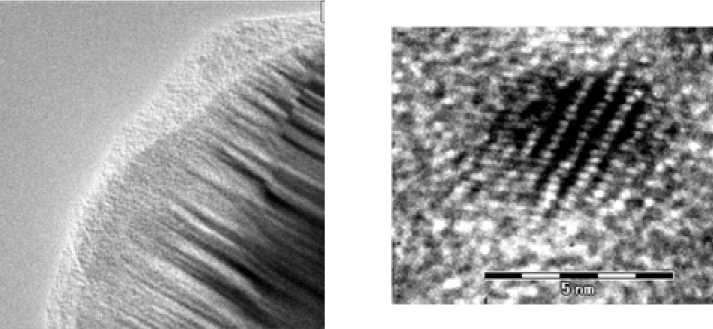
a b
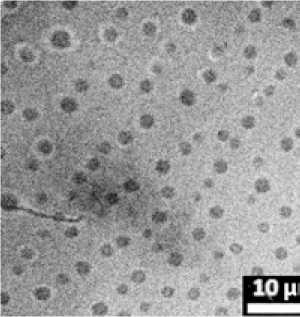
a
Fig. 1. High resolution electron microscopy image of microstructure Fe 86 Mn 13 C alloy after loading in liquid nitrogen each dark region is magnetic martensite phase: а – thinning foil; b – thin film
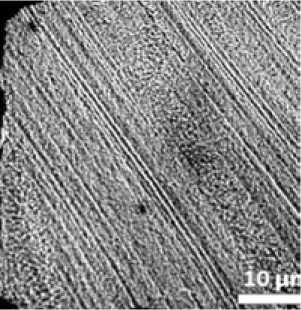
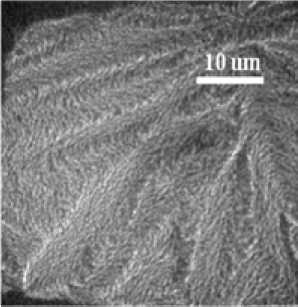
c
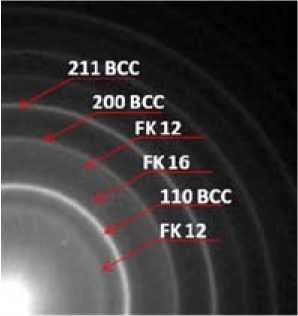
Fig. 2. The Lorentz electron microscopy images of domain structures Fe86Mn13C films obtained at different temperatures of substrates: a – 200 °C; b – 300 °C; c – 400 °C; d – the picture of electrons diffraction for 400 °C
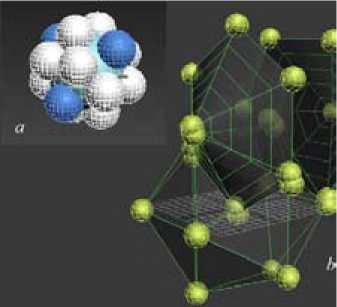
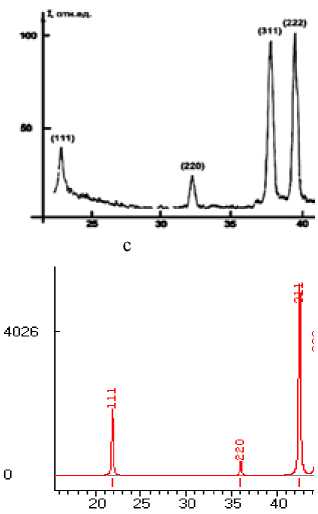
d
Fig. 3. The structures of Frank-Kasper FK 16 and FK12: a – the model of cluster FK 16; b – Frank-Kasper structures MgCu 2 (FK 16 + FK12); c – X-ray diffraction spectra from thinning foil Fe86Mn13C alloy; d – X-ray diffraction spectra for the structure MgCu2, consist of clusters FK 16 and FK 12
According to works of V.E. Panin [8] nucleation phase and martensite deformation in alloys occurs at deformation defects. The author describes a deformable solid as a multilevel nonlinear hierarchically organized system. Considered highly excited structural states, among which in a deformed crystal are allowed new structural condition. Changing the interatomic distance causes the occurrence of the bifurcation of the potential minima of the particles.
With increasing degree of plastic deformation, the translational invariance of the crystal decreases progressively [8]. The curve of the nonequilibrium thermodynamic Gibbs potential on the molar volume (Fig. 4,a) each type of defect deformation as soliton curvature certain scale level, characterized by a local minimum (Fig. 4,a). Transition of an atom soliton curvature on structural levels at the bifurcation sets short-range order displacements are characterized by their own local non-equilibrium Gibbs potential [9], Causing the appearance of a local minimum of the curve F (υ).
This causes metastability deformation defects of all types. The consequence of this is the possibility of the coexistence of a wide range of structural states (Fig. 2). When martensitic transformations induced deformation may exist martensitic phases with different structures. Thus, in Fig. 2 for processing cryomechanical alloy thin film Fe-Mn-C austenite is transformed into martensite. He may have not only traditionally known BCC structure, but also the structure of the type Frank-Kasper FK12, FK14 and FK16 (Fig. 2, d).
FK16 structure received after laser irradiation of a thining foil Fe 86 Mn 13 C alloy. This X-ray diffraction pattern presents on Fig. 3,c. To identify the diffraction pattern shown Fig. 3,c we used a typical X-ray diffraction picture of compound CaCu5, having a structure of FK16 (ASTM tables).
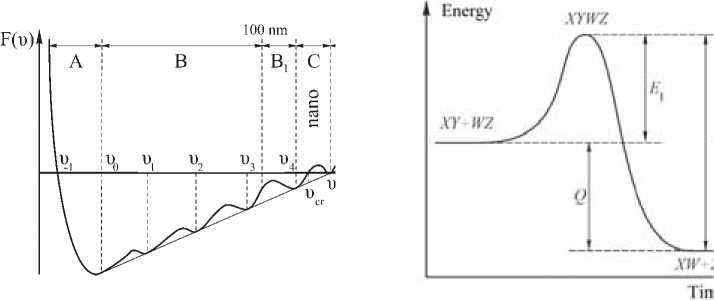
a b
Fig. 4. Energy diagrams state of material subjected to plastic deformation: a – dependence of thermodynamic potential of Gibbs F (υ) from the molar volume and taking into account local bands of a hydrostatic tension of various gauge in which been arise the defective structures. Fields of various states: A – hydrostatic squeezing;
B – mesosubstructures of various gauges; B1 – nanoscale structures; C – nanostructures states; D – porosity and fracture occurrence [3]; b – potential barrier at mechanochemical reactions, XY+WZ initial state connected atoms X,Y,W,Z. The state of excited atoms XYWZ and final state with a new structure and new connections XW+ZY [10]
Fig. 4,b. illustrates the change in the energy of the system as a result of the plastic deformation. The release of energy leads to the excitation of self-propagating high-temperature synthesis in multilayer thin films structures. XY+WZ – the chemical bonds XY and WZ before the plastic deformation. When atoms are shuffled in and out of the equilibrium position, then begin to move freely with energy higher than the energy of the potential barrier. The emitted energy E2-E1=Q ensures continuity of the process. Thus atoms move at a speed of about several km/s.
Any excess of the yield stress generates a wave of plastic deformation [8]. Wave of plastic deformation consists of one longitudinal and two transverse modes so any shift creates turn. Such rotation is facilitated if the state of the solid becomes a liquid-like, according to the work of [11]. In the wave structure of matter corresponds to irreversible changes in the liquid phase.
Modular organization is the result of cooperative displacements of atomic groups (clusters). An example of such clusters can be packed structure which is represented as a face-centered cubic cell (Fig. 5,a). It consists of an octahedron surrounded eighth tetrahedral.
According Shal’nikov [12] liquid-like metallic phase consists of clusters if the system temperature is above 4K.
We have proposed decoding scheme similar electron diffraction using modular design elements proposed in [13]. Assembled according to the electron diffraction pattern cluster is shown in Fig. 5, ab [14]. It consists of three modules FCC lattice connected to the nucleus in the center of the tetrahedral (see Fig. 5,b). The plane (110) FCC coincides with the plane of the drawing. The scheme shows that in such a modular assembly of the vector [111] of the 1st module is almost parallel to the vector [002] of the 3rd module, etc. Each module of the FCC lattice consists of two tetrahedral and one octahedron (indicated in gray). Vectors [111] and [200] relating to the modules of different groups are parallel to each other. It is impossible to implement in a cubic crystal, but is easily – 53 –
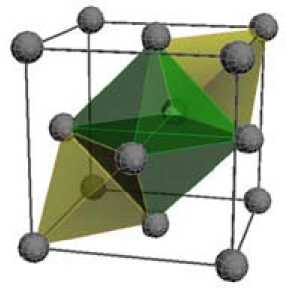
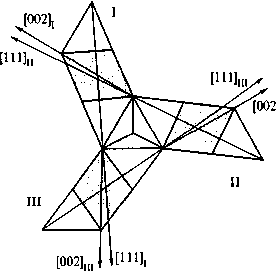
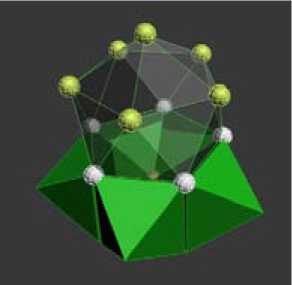
Fig. 5. The clusters structure models: a – FCC austenite initial state; b – the formation of clusters FK12 martensite structure. Three sectional FCC cube by diagonal plane type 110. The center triangle is projection tetrahedral clusters of fcc-lattice [14]; c – cluster assembly consisting of icosahedra (FK12) and five octahedral (fragment of string propagation); d – the propagation strings deformation martensite
b
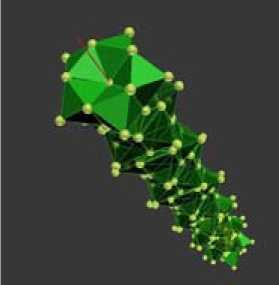
d
implemented in a modular assembly, the center of which is tetrahedral close-packed cluster. Such modular assembly percolation way fill the space.
The modeling of deformation martensite obtained by combination of icosahedrons (FK 12) and octahedrons. Icosahedron is a polyhedron with tetrahedral close-packed structure Frank-Kasper FK12. On Fig. 5,c the initial cluster (consists of five octahedra and icosahedron) is shown. On Fig. 5.d the cluster expanded with new icosahedron and octahedron is shown.
In thin film alloy samples Fe86Mn13C, subjected cryomechanical processing observed optical transitions. In Fig. 4.1 shows the spectra of the optical absorption alloy film Fe 86 Mn 13 C before (lower spectrum) and after (upper spectrum) cryomechanical processing. The spectrum obtained from the film after cryomechanical processing includes sharp peaks, in contrast to the initial state of the film. We see five distinct reflections at certain wavelengths.
In Fig. 6,b shows the calculated spin-polarized electronic density of states by the scattered waves Slater fragment for clusters FK 12 connected with 5 octahedrons (fragment of string propagation), simulated by the method of Slater theory of the scattered waves. Combined density of states for spin “up” and “down” reveals the following feature: the Fermi level (EF = -0.807 Ry) falls in the region, which is characterized by a large gap in energy for spin “down” and “gap” spins “up” . This shows – 54 –
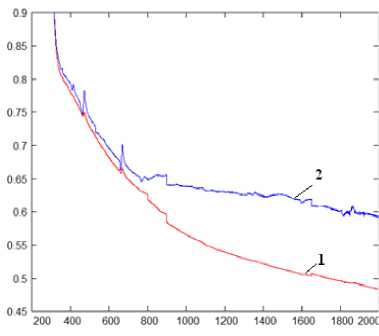
Fig. 6. The comparing energy of the optical transitions with energy obtained from the calculation of the spin-polarized electron density of states for FK 12 connected with 5 octahedrons: a – optical absorption of the film Fe86Mn13C: 1 – before 2 – after cryomechanical processing, the absorption spectrum containes lines which probably are the result of exciton absorption; b – spin polarized density of electronic states for clusters FK 12 connected with 5 octahedrons (fragment of string propagation)

b
that the electron mobility for the type of structure can be limited, and this leads to the possibility of semiconducting properties.
Conclusion
In this paper, self-assembly phenomena experimentally observed crystal and magnetic structure at different levels of scale. Experimental results are compared with the concept of self-assembly structure in a solid state subjected to plastic deformation. This conception was offered in the works V.E. Panin with employees.
Nature thermoelectric and magnetoresistive properties can be related to the heterogeneity of the phase composition formed in martensitic transformations.
Comparing the energy of the optical transitions obtained experimentally with the calculated data for the energy gaps of the electronic states with spin “up” and spin “down” for a cluster – track rod prorpstaniya come to the conclusion that they are very well coincide with the approach of the order of 0.001 P. Consequently, This theory is well confirmed by experiment, that can serve as proof of the existence of so-called rods sprouting in the alloy samples Fe86Mn13C, kriomehanicheskoy undergoing treatment.
Acknowledgments
The authors thank to Zhigalov V.S., Kirensky Institute of Physics Russian Academy of Sciences Siberian Branch, V.N. Cherepanov, A.V. Nyavro Tomsk State University for assistance.
This work was supported by a grant № 278 from the Ministry of Science and Education of the Republic Kazakhstan.

